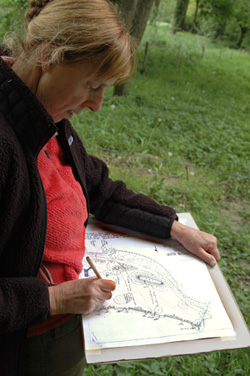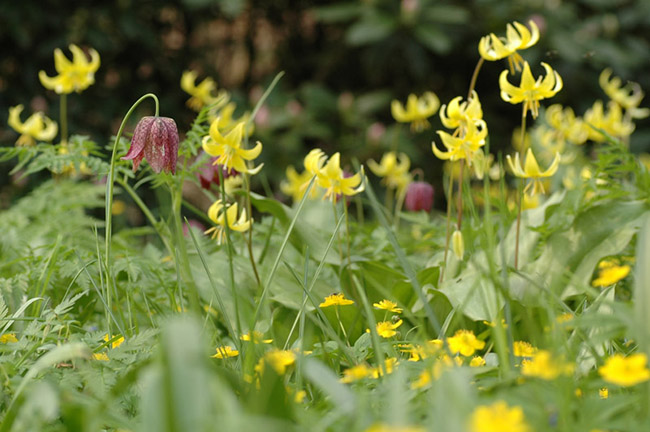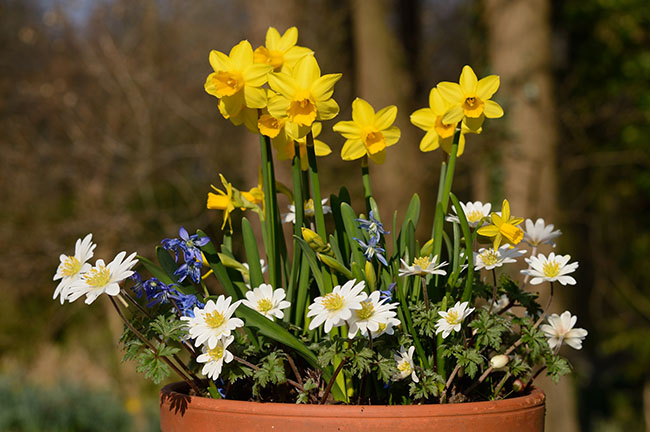 It’s best to plant bulbs according to a planting plan.
It’s best to plant bulbs according to a planting plan. The plan doesn’t have to be a botanical top creation, as long as you take into consideration the following pointers we’ve listed on this page.
Suitable planting places
Plant the bulbs somewhere that won’t be disturbed by digging spades; bulbs need year-round peace and quiet to establish themselves successfully. Suitable places are: under deciduous trees and shrubs, amongst perennial plants in a border, or in areas of low-growing groundcover, such as in patches of Lily of the valley, Dead nettle or Periwinkle.
To create a real spectacle of colour in spring, plant bulbs that are suitable for naturalising in larger areas. For example, in an orchard, on a grass verge, along the edge of a golf course, in a cemetrie or alongside a drive.
When bulbs are planted in grass make sure that the bulbs have set seed before the grass is mown. This is usually 6 weeks after the bulbs have finished flowering. Depending on the flowering time of the bulbs this will be in May or June.
Points to consider: The soil type
The most bulbs aren´t that fussy. If a bulb does require a specific soil type, then this is mentioned in the plant description.
The position
Sunny, shady, moist or dry? The majority of our bulbs aren’t too choosy. But as with the soil type, if a bulb does have a preference then this is listed under the plant description.
Combining different species of bulbs Bulbs create a restful composition when planted in groups of the same sort. Same-sort groups can be repeated throughout larger gardens or in a border, each group differing in size.
Bulbs that have different flowering periods can be planted in mixed groups. For example, Scilla siberica (flowers in March) en Fritillaria meleagris (flowers at the end of April) are good companions.
Mixing different species and varieties of bulbs that have the same flowering period can result in a stunning spring picture, but does require some experience for it to succeed. However, it is definitely possible and if you want to give it a try just make sure that the bulbs are a good match for each other, both in terms of vigour and colour.
It is best to start with a main group of one sort, then adding a second sort in patches of varying sizes. A ratio, for example, of 80-20 is best. If you’re feeling brave, then add a third, or even a forth sort in ratios such as 70-20-10 or 60-20-15-5.
 Snake’s head fritillary, Dog’s tooth violet and Yellow anemone flower together in our stinzen meadow at our garden, De Warande. Combining bulbs with perennials
Snake’s head fritillary, Dog’s tooth violet and Yellow anemone flower together in our stinzen meadow at our garden, De Warande. Combining bulbs with perennials Our bulbs are hardy and therefore return every year, although the foliage does die back after flowering. To avoid empty spaces in the garden when the foliage has died back, it’s advisable to combine the bulbs with perennials in a border, or between ferns in a shade-garden. Then there’s never a gap in your garden! During our spring garden open days we sell different sorts of shade-loving plants that are suitable for combining with stinzenplants and bulbs.
Late spring-flowering bulbs, such as Camassia and Allium varieties, are beautiful combined with unfurling perennials. For example, Water avens (Geum rivale) with the Spanish bluebell (Hyacinthoides hispanica), or Hosta with Camassia, or Rodgersia with Allium ‘Purple Sensation’...so many possibilities...be creative!
Bulbs in pots Bulbs can be planted in pots, and our bulbs are ideal for this! It’s no problem to leave a pot of bulbs outside in the winter, as long it doesn’t get too wet.
 Simple but oh so cheerful! Narcis 'Tête-à-Tête' with Anemone blanda 'White Splendour' and Scilla siberica.
Simple but oh so cheerful! Narcis 'Tête-à-Tête' with Anemone blanda 'White Splendour' and Scilla siberica. Plant the bulbs using the ‘sandwich system’ for continual flowering. This is where the latest flowering bulb is planted the deepest. A possible combination: the white Winter windflower (Anemone blanda 'White Splendour'), Grape hyacinth (Muscari botryoides ‘Superstar’) and Old pheasant’s eye (Narcissus poeticus).
Bulbs can also be combined with perennials in pots. For example, Helleborus orientalis with the blue Winter windflower (Anemone blanda 'Blue Shades’) and an early-flowering Grape hyacinth (Muscari azureum),or Forget-me-not (Myosotis alpestris) with Narcissus 'Thalia'.
 It’s best to plant bulbs according to a planting plan. The plan doesn’t have to be a botanical top creation, as long as you take into consideration the following pointers we’ve listed on this page.
It’s best to plant bulbs according to a planting plan. The plan doesn’t have to be a botanical top creation, as long as you take into consideration the following pointers we’ve listed on this page.  Snake’s head fritillary, Dog’s tooth violet and Yellow anemone flower together in our stinzen meadow at our garden, De Warande.
Snake’s head fritillary, Dog’s tooth violet and Yellow anemone flower together in our stinzen meadow at our garden, De Warande. Simple but oh so cheerful! Narcis 'Tête-à-Tête' with Anemone blanda 'White Splendour' and Scilla siberica.
Simple but oh so cheerful! Narcis 'Tête-à-Tête' with Anemone blanda 'White Splendour' and Scilla siberica.